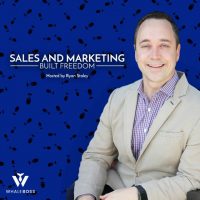- Leveraging Linkedin to Grow Revenue without Automation with Mark Firth
Are you tired of constantly receiving tons of spam from automated businesses? Although business automation is a growing trend right now, it is not for everyone. Today’s guest, Mark Firth, is a B2B Growth Expert who leverages LinkedIn regularly. He has attracted hundreds of clients to his business and made millions of dollars since early 2018. Yet, he has not touched a single piece of software in all that time.
Mark is joining us today to share his zero automation approach to running a successful business.
>>>Grab your Free Copy of “The 4 Biggest Mistakes That Stop Companies From 10X’ing Their Revenue” at https://www.scalerevenue.io/10x<<<
Mark began his career in B2B sales in 2003, doing cold-calling. He started at IBM, then worked for Siemens, and then for what was known as the Dealer Channel in Telecommunications and IT in the United Kingdom.
Mark went into corporate to make money, have time, and get freedom but got none of those. Although he was earning six figures, it was not enough for what he wanted to do with his life. So, by the time he turned 30, he had had enough of the corporate world.
Mark started his business, Linkedpreneurs, to help other small and solo business owners to grow their B2B closed share consulting or small businesses. The difference between Linkedpreneurs and other organizations is that they use zero automation. Although Linkedpreneurs leverages LinkedIn, they have not used any software since early 2018. They believe in relationships, informing, entertaining, and educating.
In 2018, Linkedpreneurs stopped getting any leads. Immediately, they saw what that meant in terms of response, engagement, and quality of prospects. So over the next month, they messaged a subset of people personally and asked them why they did not respond. 80% of the replies they received fitted into 3 categories:
I get so many of these messages every day, so leave me alone. (I.e. Linkedpreneurs were no longer standing out.)
I’m not looking for what you are selling right now. (I.e. they were triggered in the wrong way. Statistics say only 3% of people are buyer-ready.)
I can’t take you seriously when you send automated messages.
After that, they set about designing a system of personalization. It was a way of starting conversations using the information already available from people’s profiles to understand a bit about them. They supplemented that with a 2-minute video strategy, and it worked very well! Using that process got them hundreds of clients and made them millions of dollars!
Mark has systemized his way of doing manual messages by leveraging LinkedIn to start conversations with people. Conversations need context, so by looking at people’s LinkedIn profiles, he can find out everything he needs to know about them to create the reason for starting a conversation with them.
Everyone loves talking about themselves. Typically, Mark starts a conversation with someone on LinkedIn by asking them a relevant question about something going on in their life. That shows them that he has taken the time to look at their LinkedIn profile and paves the way for an intelligent level of conversation.
Give people context. Give them the seeds for a conversation, and create a grey opportunity for them to talk about how they are dealing with challenging circumstances.
Mark calls the second thing he does ‘Experts Take a Stance’. Everyone is asking questions, so you don’t stand out that way. The best way to elicit information from someone is to make a statement about a polarizing issue and give them the chance to correct what you have said. It will help you to select the individuals who share your interests and are up for a conversation.
All the B2B sales methodologies are based on open questions. However, Mark and his team have found that using statements is much more powerful than asking open questions.
The biggest mistake that Mark sees people making on LinkedIn right now is following the influencers. The content of many influencers is very broad, so you need to take a deeper look at what they are doing and know that it is a fit for you before following them blindly.
The biggest mistake that Mark used to see was people trying to follow the automation.
With B2B, you need to have a very specific market message match, and you need to focus on very specific problems. Otherwise, you could end up with lots of followers who do not need your service.
Mark feels that the direct messaging strategy is rarely an issue because direct messaging still works for some niches and offers. The product to offer is usually the issue, so people need to get more creative coaching.
If you want to work with someone to grow your business, find someone who understands marketing, and not with someone who understands a subset of tactics within marketing. The people you work with need to understand what the problem is that they are solving.
Be careful online. Do your due diligence. The general rule is that when something feels off online, it usually is.
Mark’s framework that you can apply to grow your mid-market B2B business:
Forget about cold-prospecting and draw a timeline of your life. Include everywhere you lived, worked, and the schools, colleges you went to.
Cross-reference those searches on LinkedIn.
Message those people and start a conversation with them. Then ask to connect. By doing that, your conversation will have context.
Once you have the process up and running, you can outsource it to a virtual assistant or a staff member.
Reframe your thinking. Think about context rather than lead generation. Start thinking about areas of commonality and shared interests to create the context for conversations with people.
Links and resources:
Mark Firth on LinkedIn
Mark’s website
See omnystudio.com/listener for privacy information.

